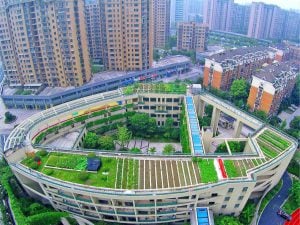“Just who do the streets belong to?” asks Chen Jiajun from the environmental group Green Bike Transit to a packed audience at a book talk in Guangzhou, a bustling city of 14 million people north-west of Hong Kong. “Planners? Designers? Managers? Or the ordinary people?” he suggests.
This is the question that Shanghai Street Design Guide, a new design manual from the government’s urban planners, sets out to answer. Published by Tongji University Press in October 2016, it makes the case for re-designing built-up spaces around the human experience, an idea that is garnering interest across China.
So what might this look like in practice? The authors paint an idealised picture:
“Neighbours run into each other and chat by the side of the road, kids play on the pavement, lovers sit out and enjoy afternoon tea, runners take advantage of tree-shaded avenues, shoppers peer into shop windows, street artists immerse themselves in their performance…”
In other words, streets that belong to the people.
Compiled jointly by the Shanghai Bureau of Planning and Land Resources, the Shanghai Transportation Commission and the Shanghai Urban Planning and Design Research Institute, the bureaucratic roll-call might lead you to expect a dull and dry read but surprisingly the book has the voices of people dead centre.
It argues that it’s high time that streets were reformed. They should be places where residents spend most of their time, and the physical embodiment of a city’s history and culture. The model of urbanisation that has privileged growth in car use must change. The roads must be reclaimed.
Narrow road ahead
Shanghai has been at the forefront of China’s development, and the changes wrought on its streets echo those that have happened elsewhere across the country.
The guide’s first chapter looks back at the history of Shanghai’s transformation, to the colonial concession era, to the foundation of the People’s Republic and the dawn of the 21st century. Key to its transformation has been how road networks have expanded and become places for vehicles rather than pedestrians.
During the concession era (1863–1941) Shanghai’s economy boomed and carts, cars and trolley-buses became more numerous. Streets gradually widened to meet the growing demand for transportation. After the market reforms and “opening up” led by Deng Xiaoping in the 1980’s, productivity increased and living standards rose across the city. People started to buy cars.
Road networks expanded to accommodate cars and ease their passage, turning streets into car-oriented spaces.
By changing the dimensions of roads the texture of the city was altered, too. Regulating the flow of traffic required roads to become wider-and-wider; more turns were added. The size of residential city blocks also became larger and the number of throughways within those blocks declined. Cars gathered on the main roads, which became badly congested.
To reduce this, roads were widened again, and Down’s Law came into effect. This states that if governments do not properly manage and control congestion, new roads will create new traffic, and that traffic will always exceed the available capacity.
Meanwhile, roads have come to prioritise the passage of vehicles, to the detriment of other users such as pedestrians and cyclists. Even smaller streets, where speeds are slower, are designed to serve cars rather than fulfil their original purpose of providing a public space for people to inhabit and communicate.
International responses
These developmental changes are similar to those experienced in the US and Europe over the past 50 years although responses to the rise of car ownership have varied across the globe.
In the 1970s, Holland came up with its Living Street approach; the United Kingdom its Home Zones; the US its Complete Streets; Australia its Shared Zones; and Belgium and Canada the Woonerf (Living Yard).
These approaches shifted the focus away from motorised transport and back to people, emphasising respect for the public’s right to use the streets.
Cities also came up with their own design principles to suit their needs and reform their streets. The principles applied in New York, London and Abu Dhabi all have their own characteristics.
The streets belong to people
Today, China is trying to reverse decades of enthusiastic urban construction and bulldozing of ancient buildings by creating modern cities that are liveable, vital and individual.
Better street design is key to this. And how Shanghai, which is at the forefront of China’s urbanisation and modernisation, redesigns its streets will show the way for other cities.
Rather than focus on motor vehicles and transportation, the guide suggests “paying attention to how people meet and live”, and “promoting the joint development of neighbourhoods and streets”.
The guide makes practical suggestions, too, such as reducing the space for cars, giving priority to slower forms of transport by creating space for walking, unhindered lanes for bicycles, tighter turns in roads, and improved pedestrian crossings.
It also takes the needs of different groups into account, recommending the introduction of public spaces for resting, pavement cafes, street lighting, transparent building facades, and 24-hour security monitoring. Finally, it emphasises the value of local features that embody history and culture.
Although aimed at urban planners, the book is big on public participation. Over one hundred experts from dozens of different bodies contributed, but tens of thousands of city residents provided feedback via questionnaires and discussions.
A bigger shift
And it’s not just Shanghai, cities all over China have been making their streets friendlier. Guangzhou has trialled street remodelling and produced the Guangzhou Comprehensive Street Design Handbook. In Luohu, Shenzhen, trials of local road improvements and urban views are underway, while Changsha is piloting a “child-friendly city” project.
Of course, in China’s cities, land is hugely valuable, and various regulatory regimes and stakeholders will be involved in any street reform process, including urban planning, construction and transportation authorities, the police, parks and gardens, and grassroots government will all need to participate and cooperate. Progress will be difficult.
But China’s urban managers have already had to respond to explosive growth in shared bike schemes, which are challenging the car’s monopoly over the roads.
Urban planners will have to be creative if they really want to give the streets back to the people.
With special thanks to Li Wei and Liu Shaokun for their support in contributing to this article.
A Chinese PDF of the Shanghai Street Design Guide is available here.







![View of Pul Doda from the road above, a half submerged structures of a mosque, a temple and a few houses can be seen [image by: Majod Maqbool]](https://dialogue.earth/content/uploads/2017/10/A-view-of-the-Pul-Doda-area-from-the-road-above.-The-half-submerged-structures-of-a-mosque-a-temple-and-a-few-houses-can-be-seen-here.-300x184.jpg)
